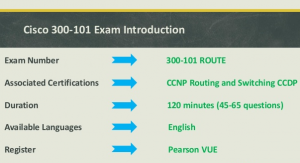Vendor: Cisco
Exam Code: 300-101 exam
Exam Name: Implementing Cisco IP Routing (ROUTE v2.0)
Version: Demo

QUESTION 1
After you review the output of the command show ipv6 interface brief, you see that several IPv6 addresses have the 16-bit hexadecimal value of “FFFE” inserted into the address. Based on 300-101 this information, what do you conclude about these IPv6 addresses?
A. IEEE EUI-64 was implemented when assigning IPv6 addresses on the device.
B. The addresses were misconfigured and will not function as intended.
C. IPv6 addresses containing “FFFE” indicate that the address is reserved for multicast.
D. The IPv6 universal/local flag (bit 7) was flipped.
E. IPv6 unicast forwarding was enabled, but IPv6 Cisco Express Forwarding was disabled.
Correct Answer: A
Explanation: Extended Unique Identifier (EUI), as per RFC2373, allows a host to assign iteslf a unique 64-Bit IP Version 6 interface identifier (EUI-64). This feature is a key benefit over IPv4 as it eliminates the 300-101 dumps need of manual configuration or DHCP as in the world of IPv4. The IPv6 EUI-64 format address is obtained through the 48-bit MAC address. The Mac address is first separated into two 24-bits, with one being OUI (Organizationally Unique Identifier) and the other being NIC specific. The 16-bit 0xFFFE is then inserted between these two 24-bits to for the 64-bit EUI address. IEEE has chosen FFFE as a reserved value which can only appear in EUI-64 generated from the an EUI-48 MAC address.
» Read more about: Pass Cisco 300-101 Test Easily With Best Cisco 300-101 Exam Study Guide »